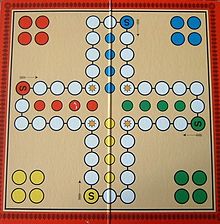Mensch ärgere Dich nicht: Difference between revisions
Frank Marco (talk | contribs) m linkfix |
Addded translation information |
||
| Line 17: | Line 17: | ||
| footnotes = |
| footnotes = |
||
}} |
}} |
||
'''Mensch ärgere dich nicht''' is a [[Germany|German]] [[board game]] (but not a [[German-style board game]]), by [[Joseph Friedrich Schmidt]] (1907/1908). |
'''Mensch ärgere dich nicht''', Literally '''Humans do not Annoy You''' (commonly known as '''Mensch''') is a [[Germany|German]] [[board game]] (but not a [[German-style board game]]), by [[Joseph Friedrich Schmidt]] (1907/1908). |
||
The game was issued in 1914 and sold about 70 million copies. It is a [[Cross and Circle game]] with the circle is collapsed onto the cross, similar to the [[India]]n game [[Pachisi]], the American games [[Parcheesi]] and [[Trouble (board_game)|Trouble]], and the [[England|English]] game [[Ludo (board game)|Ludo]]. |
The game was issued in 1914 and sold about 70 million copies. It is a [[Cross and Circle game]] with the circle is collapsed onto the cross, similar to the [[India]]n game [[Pachisi]], the American games [[Parcheesi]] and [[Trouble (board_game)|Trouble]], and the [[England|English]] game [[Ludo (board game)|Ludo]]. |
||
Revision as of 01:55, 16 January 2011
 | |
| Designers | Josef Friedrich Schmidt |
|---|---|
| Publishers | Schmidt-Spiele |
| Players | 2 to 4(6) (reverse side of board also playable) |
| Playing time | about 30 minutes |
| Chance | High |
| Age range | 5 years and up |
Mensch ärgere dich nicht, Literally Humans do not Annoy You (commonly known as Mensch) is a German board game (but not a German-style board game), by Joseph Friedrich Schmidt (1907/1908).
The game was issued in 1914 and sold about 70 million copies. It is a Cross and Circle game with the circle is collapsed onto the cross, similar to the Indian game Pachisi, the American games Parcheesi and Trouble, and the English game Ludo.

Name
The name of the game means "Do not get angry" (literally "Do not get angry, man" or "Do not get angry, buddy"). The name derives from the fact that a peg is sent back to the B field when another peg lands on it, similar to the game Sorry!.
Rules
The game can be played by 2, 3 or 4 players - one player per board side (the original one has a pattern for 6 players on its backside). Each player has 4 game pieces, which are in the "out" area when the game starts, and which must be brought into the player's "home" row. Early games had painted wooden pieces.
The rows are arranged in a cross position. They are surrounded and connected with a circle of fields, over which the game pieces move in clockwise direction. There are 3 fields nearest to each side of the board; the left one is the player's "start" field and the middle one leads to the "home" row.
This means that each game piece enters the circle at the "start" field, moves (clockwise) over the board and finally enters the "home" row. The first player with all of their pieces in their "home" row wins the game.
The players throw a die (dice) in turn and can advance any of their pieces in the game by the thrown number of dots on the dice.
Throwing a six means bringing a piece into the game (by placing one from the "out" area onto the "start" field) and throwing the dice again. If a piece is on the "start" field and there are still pieces in the "out" area, it must be moved as soon as possible. If a piece cannot be brought into the game then any other piece in the game must be moved by the thrown number, if that is possible.
Pieces can jump over other pieces, and throw out pieces from other players (into that player's "out" area) if they land on them. A player cannot throw out his own pieces though, and cannot advance further than the last field in the "home" row. A player cannot be thrown out if he is on his "start" field.
Variation which is played by most players: A player who has no pieces in the game has 3 tries to throw a six.
The players may agree to let the 3rd placed player begin the next game.
